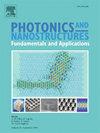Study on a simple long-wave infrared ultra-wideband metamaterial absorber with a high tolerance of manufacturing errors
IF 2.5
3区 物理与天体物理
Q3 MATERIALS SCIENCE, MULTIDISCIPLINARY
Photonics and Nanostructures-Fundamentals and Applications
Pub Date : 2025-02-01
DOI:10.1016/j.photonics.2025.101357
引用次数: 0
Abstract
Among the electromagnetic bands, the infrared band occupies a crucial place due to its wide range. Absorption in the long-wave infrared band is an important focus of infrared research and has attracted a great deal of attention from researchers. In this work, a long-wave infrared ultra-wideband absorber based on a four-layer metal–dielectric–metal–dielectric structure is proposed. In the ultra-long operating band of 8–36 μm, the average absorption rate is as high as 95.79 %, brought about by the resonance excitation of various modes, including local surface plasmon resonance, guided mode resonance, cavity resonance, magnetic resonance, and diffraction. At a large incidence angle of 60°, the absorption of the absorber can reach 91.17 % in TE mode, demonstrating insensitivity to large-angle incidence. At 1800 K, the absorber shows an emission efficiency as high as 97.01 % in the long-wave infrared range. It is worth mentioning that our absorber exhibits an extremely large manufacturing tolerance of ± 0.4 μm, making it highly suitable for practical production and application. Therefore, the proposed absorber shows promising potential in applications such as infrared imaging, infrared detection, hot electron collection, radiative cooling, and other related fields. In addition, the absorber can be used in remote sensing applications, as its operating band effectively covers the common remote sensing band from 8 to 30 μm.
具有高制造误差容忍度的简易长波红外超宽带超材料吸收体的研究
在电磁波段中,红外波段因其范围广而占有至关重要的地位。长波红外波段的吸收是红外研究的一个重要热点,引起了研究人员的广泛关注。本文提出了一种基于四层金属-介电-金属-介电结构的长波红外超宽带吸收器。在8 ~ 36 μm的超长工作波段内,由于局部表面等离子体共振、导模共振、腔共振、磁共振和衍射等多种模式的共振激发,平均吸收率高达95.79 %。在60°大入射角下,TE模式下吸收体的吸收率可达91.17 %,对大角度入射角不敏感。在1800 K时,吸收剂在长波红外范围内的发射效率高达97.01 %。值得一提的是,我们的吸收器具有极大的制造公差± 0.4 μm,非常适合实际生产和应用。因此,该吸收剂在红外成像、红外探测、热电子收集、辐射冷却等相关领域具有广阔的应用前景。此外,该吸收器可用于遥感应用,其工作波段有效覆盖8 ~ 30 μm的常用遥感波段。
本文章由计算机程序翻译,如有差异,请以英文原文为准。
求助全文
约1分钟内获得全文
求助全文
来源期刊
CiteScore
5.00
自引率
3.70%
发文量
77
审稿时长
62 days
期刊介绍:
This journal establishes a dedicated channel for physicists, material scientists, chemists, engineers and computer scientists who are interested in photonics and nanostructures, and especially in research related to photonic crystals, photonic band gaps and metamaterials. The Journal sheds light on the latest developments in this growing field of science that will see the emergence of faster telecommunications and ultimately computers that use light instead of electrons to connect components.

 求助内容:
求助内容: 应助结果提醒方式:
应助结果提醒方式:


